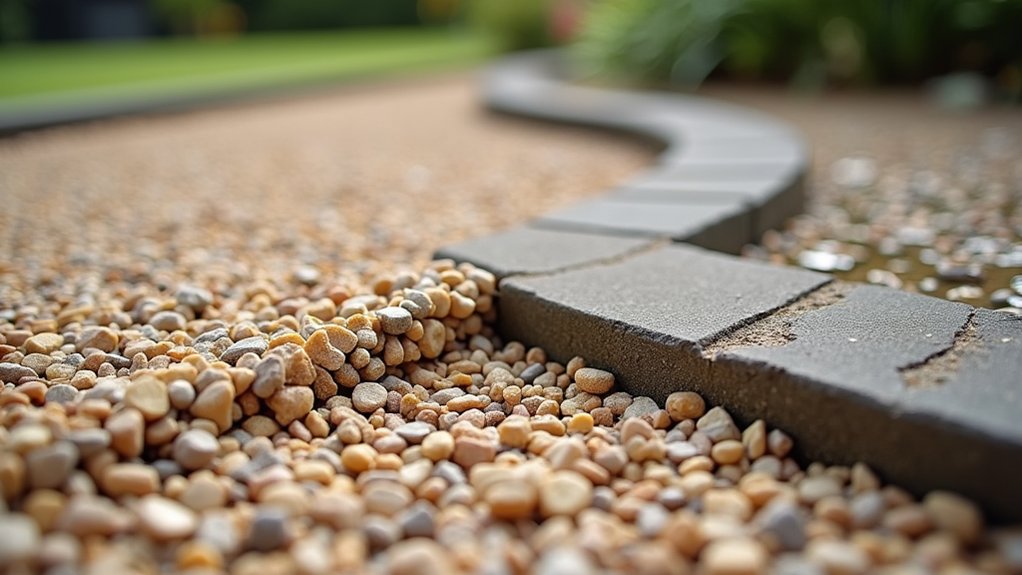Common problems with resin-bound gravel include loose stones, cracking and colour fading, typically caused by poor groundwork, incorrect resin-to-stone ratios or cheap materials. Fix these issues by ensuring a proper sub-base, using UV-resistant resins and maintaining good drainage. Regular maintenance – including brushing, jet washing and prompt cleaning of oil or fuel spills – will protect your surface. For stubborn problems like deep cracks or severe fading, you might need professional repairs to keep your driveway in top form. Much like caring for a garden path, prevention is better than cure with resin-bound surfaces.
Key Takeaways
Top Tips for Resin-Bound Gravel Maintenance
- Start with a solid foundation – dig at least 150mm deep and firmly compact the base material to stop cracks appearing down the line.
- Mix your resin properly. Skimping on quality or getting proportions wrong leads to loose stones and patchy surfaces.
- Create a gentle slope (minimum 1:60) so rainwater drains away naturally – much like a garden path. Standing water is your worst enemy.
- Keep an eye out for early warning signs. Regular checks and a good sweep will catch problems before they worsen. Think of it like checking your car’s tyres.
- Pop on a protective sealant every few years. It’ll keep the colour looking fresh and protect against oil stains, just as you’d wax your car.
Issues With Base Preparation
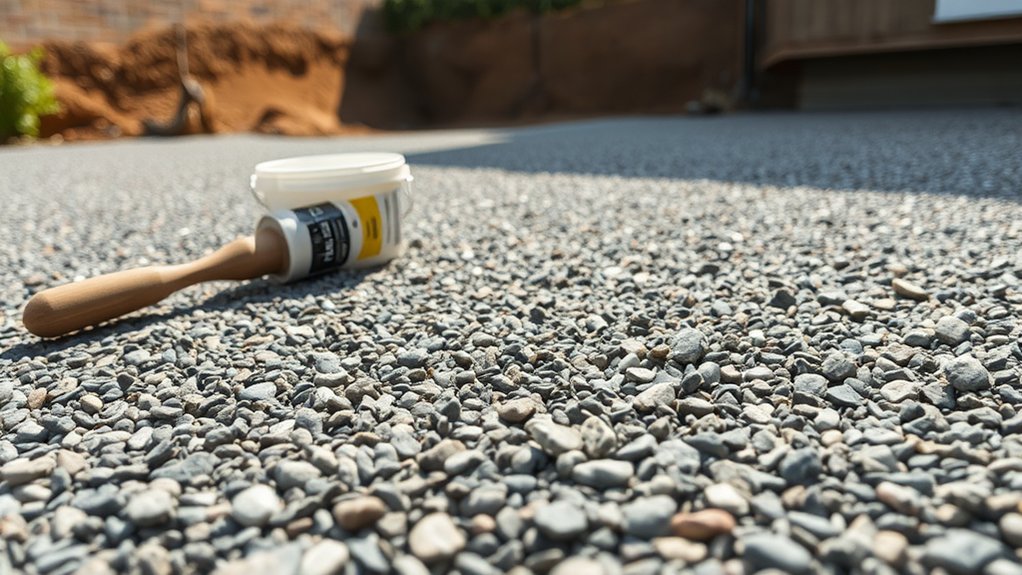
Getting your base preparation spot-on is crucial for resin-bound gravel; cutting corners here leads to headaches later. You’ll need a proper sub-base of tarmac or concrete that’s at least 150mm deep and well-compacted. Think of it like building a house – without solid foundations, everything above is at risk. Proper sub-base preparation ensures stability and prevents future issues. Poor drainage means puddles will form, whilst a thin base can crack under the weight of vehicles. If you’re laying over an existing surface, give it a thorough clean first. Only use materials rated for your expected traffic – a family car needs different support than a delivery lorry. Ensuring that the surface temperature is at least 3C above dew point is essential for successful installation. Sort the base properly now, and you’ll save yourself the bother of repairs and maintenance down the road. It’s that simple.
Causes of Loose Stones
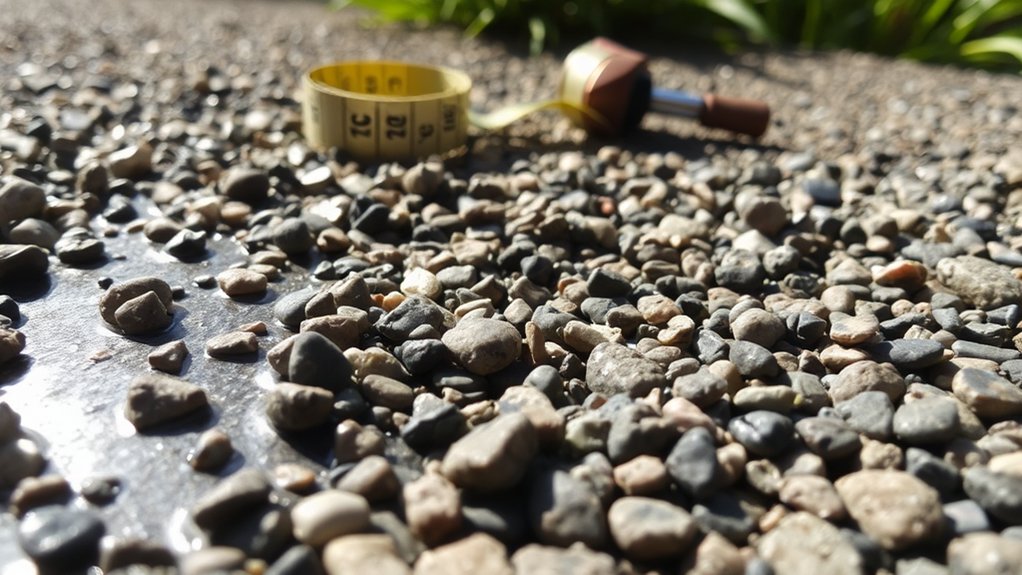
Loose stones in resin-bound gravel are often caused by several common issues.
Poor mixing, much like failing to stir paint properly, leaves stones without proper resin coating.
Using too little resin is like trying to stick something with insufficient glue – it simply won’t hold.
Getting the mix ratio wrong, a bit like making a cake with wrong proportions, leads to weak bonding.
Cheap or poor-quality resin simply won’t do the job properly, similar to using bargain DIY adhesives.
The wrong type or size of stones, especially those that are too large or dusty, won’t bond well with the resin.
Over time, exposure to harsh chemicals (like petrol drips) or heavy traffic can break down even well-laid surfaces. Additionally, improper base preparation can also lead to cracking and sinking, which exacerbates the problem of loose stones. Regular maintenance can help prevent common problems from arising and ensure your resin-bound surface stays solid and looking smart.
Discolouration and Fading Concerns
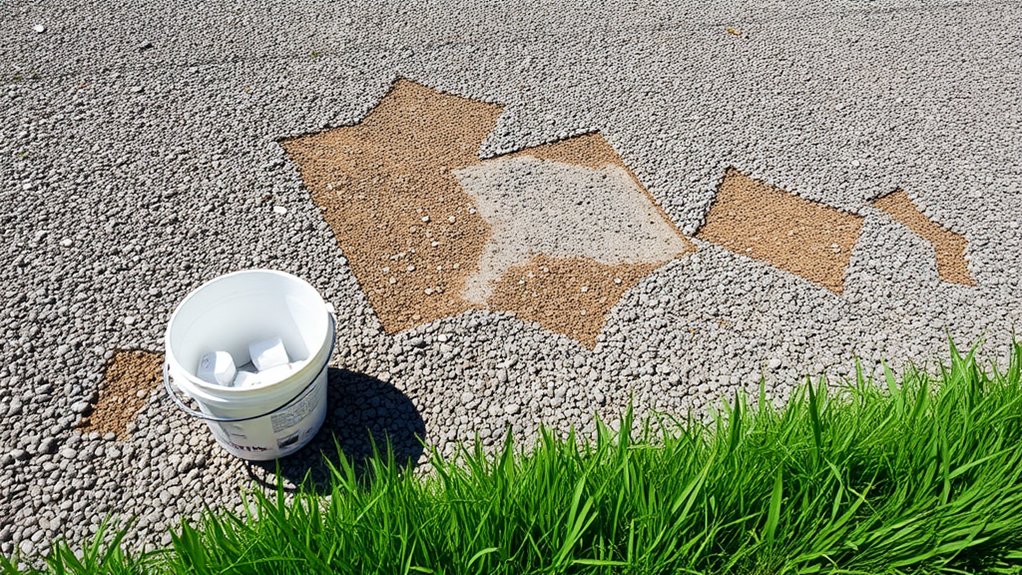
Maintaining Your Resin-Bound Gravel Driveway Colour
Keep your resin driveway looking fresh with these practical maintenance steps:
- UV-Stable Resins: Select premium UV-resistant materials – much like choosing quality outdoor furniture – to prevent colour fade. Using UV stable resin helps maintain the aesthetic appeal over time, ensuring that your driveway remains vibrant even under prolonged exposure to the sun.
- Quick Spill Response: Wipe up oil, petrol or garden chemicals straight away. A quick mop with soapy water prevents lasting stains.
- Regular Checks: Give your driveway a proper look every few months, particularly after harsh weather. Spot early signs of wear before they worsen, as proactive maintenance can guide you in preserving the surface’s integrity and appearance.
- Protective Sealing: Add a professional-grade sealant coating. Think of it as sunscreen for your driveway – it blocks harmful UV rays and protects against daily wear while enhancing aesthetics and durability.
Cracking and Surface Damage

Cracks in resin-bound gravel typically occur due to poor base preparation, ground movement or incorrect mixing ratios.
Common signs include hairline cracks near edges and surface splits after harsh weather.
A properly installed system needs adequate drainage and a solid sub-base – much like laying a proper foundation for a house.
Check your surface regularly, especially after winter, and tackle small cracks early to prevent bigger issues.
Most UK installations benefit from annual maintenance to keep the surface in top condition.
Causes of Cracking
Causes of Cracking
Several factors can cause cracks in resin-bound gravel surfaces, much like those you might spot in a garden patio or driveway:
- Base Issues: Poor ground preparation or existing cracks beneath the surface will likely cause problems above. Think of it like building on shaky foundations.
- Ground Movement: Natural settling of the ground, particularly common in areas with clay soil, creates stress points and cracks.
- Atmospheric Conditions: British weather can play havoc during installation – too hot or cold whilst curing affects resin quality.
- Improper Mixing: Getting the resin-to-aggregate ratio wrong weakens the entire surface, rather like using the wrong mix for concrete.
Spotting these issues early helps prevent worse damage.
The key is identifying the exact cause before attempting repairs, ensuring you fix the underlying problem rather than just patching the surface.
Prevention Techniques
Preventing Cracks in Resin-Bound Surfaces
Quality materials are your first defence against cracking in resin-bound gravel. Choose premium resin and aggregates from trusted UK suppliers – it’s worth the extra cost.
Ensure proper installation by allowing sufficient curing time and managing weight distribution – much like avoiding walking on fresh concrete.
Keep an eye on your surface with regular checks and sweep away debris before it causes problems. A surface sealant every couple of years works brilliantly against our British weather and harsh UV rays.
During installation, use proper barriers (like those you’d see at roadworks) to keep people off until fully set.
Think of your resin surface like a good pair of boots – look after it properly, and it’ll serve you well for years.
Regular maintenance spots tiny issues before they become costly repairs, whilst proper installation sets the foundation for lasting durability.
Drainage and Water Pooling Problems
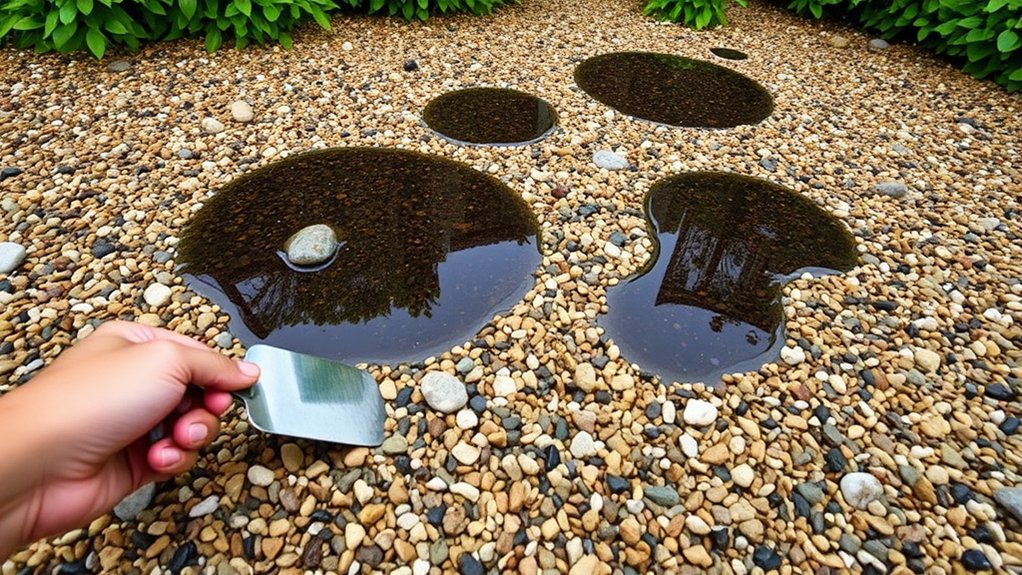
When installing a resin-bound gravel driveway, proper drainage is essential.
Create a minimum 1:60 slope to prevent water pooling, and ensure all drainage channels remain clear of debris.
The sub-base choice matters too – a well-compacted MOT Type 1 stone base works best for British weather conditions.
Much like a garden path that slopes away from your house, your driveway needs the same consideration to keep it puddle-free and functional year-round.
Insufficient Slope Issues
Proper Driveway Slopes for British Weather
A poorly sloped resin driveway will leave you with puddles and drainage headaches. Sort these basics to keep your drive water-free:
- Check the gradient: Your driveway needs at least a 1:60 fall (roughly 2%) to shift rainwater properly. Think of it as a 1cm drop for every 60cm length.
- Get the base right: A solid MOT Type 1 sub-base, properly compacted, stops dips forming where water can collect.
- Add proper drainage: Simple channel drains or ACO drains at the bottom of your slope make all the difference, especially during those typical British downpours.
- Keep an eye out: Give your driveway a quick check after heavy rain – any puddles mean you’ve got drainage issues to sort.
Clogged Drainage Systems
Clogged drains can seriously damage your resin-bound driveway, causing water to pool and potentially harm its structure.
When autumn leaves, garden waste or soil block the drainage, you’ll notice puddles forming that encourage moss growth – making your driveway slippery and unsightly.
Sort the problem by regularly sweeping your driveway and checking the drainage channels.
Set up a simple maintenance routine, perhaps monthly, using a garden hose or stiff brush to clear any build-up.
Adding drainage grids is worth considering, especially if you’ve got overhanging trees nearby.
If you’re still having issues after trying these fixes, get a professional in.
They’ll properly assess the situation and sort any repairs needed to keep your driveway in top condition.
Base Material Considerations
Base Material Considerations for Resin-Bound Gravel
The right base material directly affects how well your resin-bound surface drains and prevents puddles. Key factors to consider:
- Permeability: Open-textured tarmac or EcoGrid works best – much like a well-draining garden soil.
- Compaction: A firmly packed base prevents dips and bumps, similar to preparing ground for a garden patio.
- Thickness: Keep to at least 100mm depth – roughly the height of a cricket ball.
- Material Choice: MOT Type 3 aggregate offers reliable stability, whilst concrete needs a full week to cure properly.
Sound aggregate selection vastly improves drainage and stops water collecting.
These practical steps create a lasting, effective surface. Regular checks and maintenance keep it performing well year-round.
Effective Prevention and Maintenance Strategies
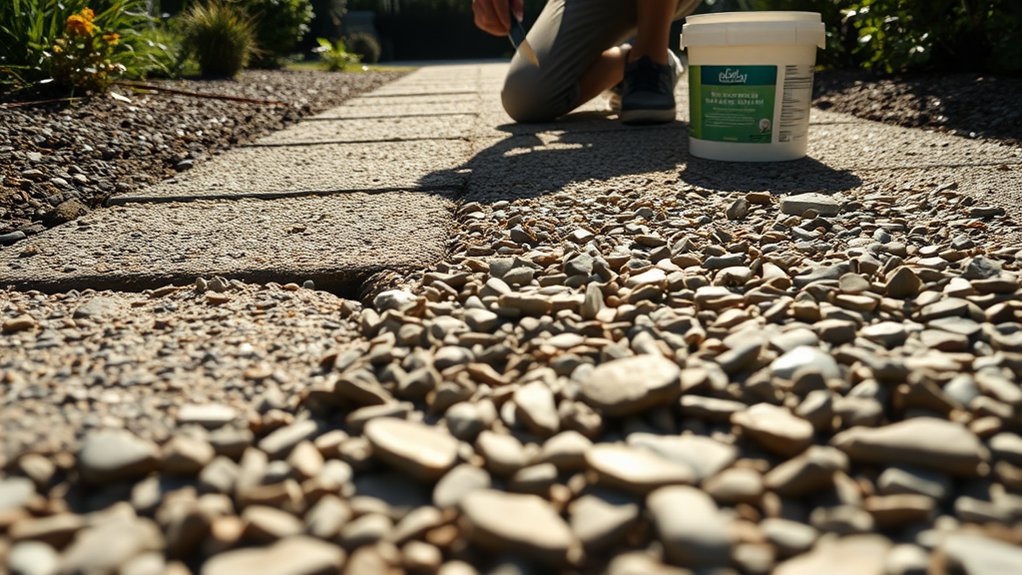
Regular maintenance is vital for resin-bound gravel driveways and paths to last.
First, check your site’s drainage and gradient to stop water pooling. Give surfaces a good sweep weekly and power wash yearly to keep them looking fresh. Don’t use harsh cleaning products, as these can damage the resin binding.
Set up seasonal checks to spot any cracks early, and apply a protective sealant when needed.
Pop down a weed membrane during installation to stop unwanted growth, and clean up any oil or fuel spills straight away to avoid stains. It’s worth getting a professional round once a year to check for any hidden problems – much like an MOT for your car.
Keep notes of when you’ve done repairs or maintenance, as this helps track any recurring issues.
With proper care, your resin-bound surface should stay smart and serviceable for many years.
Frequently Asked Questions
How Long Does Resin-Bound Gravel Last With Proper Maintenance?
A well-maintained resin-bound gravel driveway typically lasts between 15 and 30 years. Regular sweeping, occasional pressure washing and prompt repairs of any damaged areas ensure maximum longevity. The lifespan largely depends on proper installation using quality materials and the level of traffic the surface receives.
Can Resin-Bound Gravel Be Installed Over Existing Surfaces?
Resin-bound gravel can be installed over existing surfaces, but proper preparation is essential. The base surface must be stable, clean and completely dry before installation begins. Suitable surfaces include concrete and tarmac, whilst loose or damaged surfaces will need repairs or replacement first.
For best results, the existing surface requires thorough cleaning and any cracks must be properly filled. The surface should have adequate drainage to prevent water pooling, which could compromise the resin bond over time.
Common installation surfaces include:
- Concrete driveways
- Tarmac paths
- Well-maintained patio areas
- Stable block paving
The finished result will only be as good as the surface beneath it, so getting the groundwork right is crucial for longevity.
Is Resin-Bound Gravel Suitable for All Climates?
Resin-bound gravel works well in most British weather conditions, though proper installation timing is crucial. Best fitted on dry days between 5-25°C for optimal results. Whilst it handles our typical rain and frost admirably, laying it during extreme cold or wet weather can affect its durability. Think of it like painting your garden fence – you’d wait for decent weather to ensure the best finish.
What Types of Vehicles Can Safely Use Resin-Bound Surfaces?
Resin-bound surfaces handle most everyday vehicles well, from standard family cars to transit vans. Whilst suitable for regular traffic, these surfaces work best with vehicles under 7.5 tonnes. Heavy goods vehicles and industrial machinery may require a more robust surface solution.
How Can I Enhance the Aesthetic Appeal of Resin-Bound Gravel?
Select complementary colours and decorative aggregates to boost your resin-bound gravel’s visual impact. Mix light and dark stones, perhaps combining warm buff tones with grey flint, or opt for striking contrasts like slate black with silver granite. For a truly British garden look, try incorporating local stone varieties that match regional architecture. Well-chosen blends can transform a basic driveway or path into an eye-catching feature that enhances your property’s kerb appeal.
Conclusion
Proper care of resin-bound gravel helps maintain its durability and appearance. The key issues, such as poor base preparation and inadequate drainage, can be managed with the right knowledge. Think of it like caring for your garden path – regular checks and maintenance prevent problems from worsening. Keep an eye out for loose stones and discolouration, addressing them promptly. Sound upkeep protects your investment and keeps your outdoor space looking smart.
